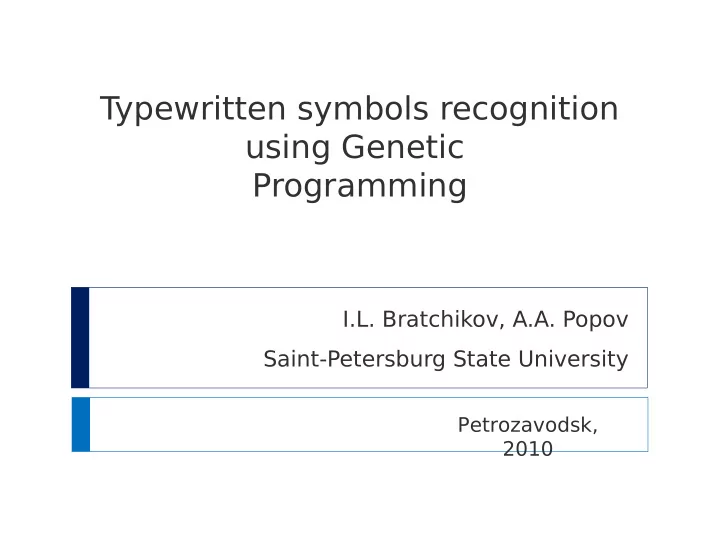

T ypewritten symbols recognition using Genetic Programming I.L. Bratchikov, A.A. Popov Saint-Petersburg State University Petrozavodsk, 2010
Table of contents Table of contents Purposes and goals Description of a problem What is Genetic Programming (GP)? How does it work? Typical scheme Adding GP to the problem Results In perspective
Purposes and goals Purposes and goals The main purpose: To estimate the application of GP for the problem of typewritten symbols recognition The goals: To determine the superiorities of GP in comparison with the other approaches To develop specific terminals, functions, fitness measure, certain parameters for controlling the run, the termination criterion and method for designating the result of the run.
Description of a problem Description of a problem The main problem is to recognize the typewritten Cyrillic and Latin symbols. It means the electronic or mechanical translation of scanned images of printed or typewritten symbols into machine-encoded text.
What is GP? What is GP? GP GP is an evolutionary algorithm-based methodology inspired by biological evolution to find computer programs that perform a user-defined task. It is a specialization of genetic algorithms where each individual is a computer program.
How does it work? How does it work? In so few words GP is a method of solving problems using computers through an analogue of natural selection. GP evolves computer programs, traditionally represented in memory as tree structures tree structures.
Typical scheme Typical scheme
Adding GP to the problem Adding GP to the problem Evaluation of a certain solution is based on a set of entities and collects the behavior of the set solution on individual elements of this set. It's a characteristic for machine learning, where solutions are hypotheses, the set contains solutions training cases, and the evaluation function evaluation function is the accuracy of such classification.
Adding GP to the problem Adding GP to the problem For some hypothesis the evaluation function returns its accuracy of classification on the training set. Incomparability involves a partial order in the solution space and the possibility of existence of many best best solutions at the same time. We can prevent the algorithm from losing good solutions by replacing the scalar evaluation function with a pairwise comparison of solutions
Outranking relation Outranking relation Let’s define formally the outranking relation outranking relation between two solutions (hypotheses), given the sets of examples correctly classified by these hypotheses. Outranking Outranking means that first hypothesis is at least as good as a second one. This condition has to hold separately and simultaneously for examples representing some decision classes.
How to select the best solutions? How to select the best solutions? Tournament selection scheme cannot work properly in solving this problem due to the fact, that the incomparability decreases the selection pressure, so some tournaments might remain undecided. Therefore we have to select some non outranked solutions (hypotheses).
Fitness cases, symbol representation Fitness cases, symbol representation The solutions (programs-candidates) performing image analysis and recognition are evaluated on a set of training cases (pictures), called fitness cases fitness cases. The data source should be the database of typewritten symbols. It might consist of two subsets, testing and training. The symbols could be easily represented by matrix of gray level pixels. Let’s assume that the symbols are scaled and centered.
Estimated values Estimated values population size population size: 2000; probability of mutation probability of mutation: 0.05; maximal maximal depth of a randomly generated tree depth (initialization): 3 or 4; maximal maximal number of generations: 100 (stopping number of generations condition); training set training set size size: 200 cases (100 images per each class); tournament selection tournament selection.
Results Results Though GP has some evident superiorities in comparison with the other approaches such as statistics, neural networks and the other techniques, it is not an ideal approach to solve the problem. But it could be used simultaneously simultaneously with the other methods in some disputable issues.
In perspective In perspective 1. Font normalization (deskewing); 2. Development of recognition system (programming complex or toolbox); 3. Transition from typewritten to handwritten symbols; 4. Integration with the other systems.
Thanks for your attention! Thanks for your attention!
Recommend
More recommend